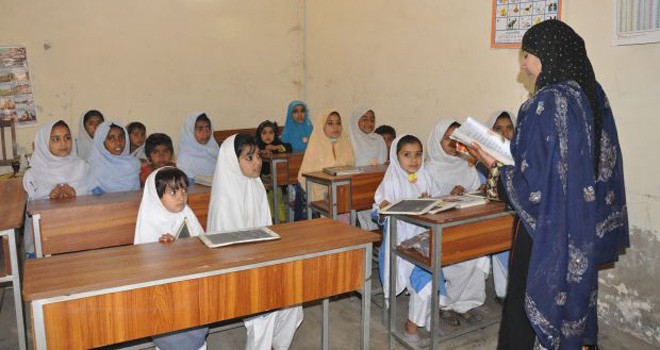
Massive underspending of development budget in Sindh denotes a lack of political commitment

The 7th NFC Award and the 18th constitutional amendment offered new political and financial opportunities to the provinces. Hefty amounts were earmarked for provincial Annual Development Plans (ADPs) but a considerable part of the allocation remained unutilised -- due to lack of political will and professional incapacity.
Utilisation of Sindh’s development budget 2014-15, for instance, depicts a dismal scenario. ADPs for the ongoing year had a sizable allocation of over Rs200 billion, including Rs64 billion through non-provincial sources whereas the province’s own development plan was allocated Rs143 billion.
But, according to the Sindh government, only Rs81 billion were released to various departments during the first nine months. That is only 57 per cent of the allocated budget.
The Sindh provincial government was able to spend only Rs51.12 billion - that is 63 per cent of the released budget and an embarrassing 35 per cent of the allocated amount. Half of the budget heads could not utilise even 20 per cent of the allocated budget. In a province with deficit in human development, malnutrition among women and children, and rickety infrastructure, massive underspending of development budget denotes lack of political commitment on the rulers’ part.
Health and education departments of Sindh utilised a meagre 21 and 27 per cent of the allocated amount, and the irrigation department used 95 per cent of its budget.
Irrigation department is an obvious priority -- not because it is the engine of local economy but because it involves massive contracts and kickbacks. The department has not had a minister for past several years, and is managed by the Sindh chief minister.
No wonder, then, the finance ministry generously released Rs9 billion to the irrigation department, surpassing the allocation of Rs8.6 billion.
Likewise, new development initiatives announced in the budget received about half of the allocated funds. It received Rs2.4 billion and consumed Rs2.3 billion. Budget documents are silent on the details of schemes under this budget head. Provincial bureaucracy is also reluctant to share any details of the schemes financed under this head.
Such allocations are complete waste of taxpayers’ money that is often used to finance prized projects of ruling oligarchy.
In complete contrast, the local government department was able to utilise only Rs6.6 billion against an allocation of Rs21.88 billion. The department deals with basic services at the grassroots level and has direct bearing on the lives of common citizens, especially low-income groups.
Also read: A fair award
Sindh’s infrastructure -- water supply and sanitation network, street pavements and public amenity spaces like parks and playgrounds -- is in shambles. Whatever amount of water is supplied is not fit for human consumption in most areas. Out of the four provinces, Sindh probably has the worst water and sanitation system. Yet, the local government department did not have the good sense to fully utilise the development budget to benefit poor constituencies.
According to official and unofficial reports, Sindh has the lowest educational standards in the country. Sindh Education Profile 2013-14 states that the school infrastructure is in a dilapidated condition and 7,461 schools are shelter-less, 23,000 schools lack drinking water facility, 20,000 schools do not have toilet facility and 11,6000 need a boundary wall. These grim findings demanded prudent utilisation of development budget.
Currently, only 36 per cent pupils complete their primary education, which indicates a pitiable dropout rate at the primary level. In spite of an emergency-like situation in the education sector, the provincial government left almost two-thirds of the allocated budget unutilised. Against an allocation of Rs10.7 billion, only Rs5.12 billion were released and only Rs2.8 billion were utilised, which is only 27 per cent of the allocation.
The health department was able to utilise only 21 per cent of the allocated budget. According to an assessment of secondary health facilities in the nine flood-affected districts of Sindh, WHO revealed that only 23 per cent health facilities had private wards and 81 per cent facilities needed repair of doors and windows. 39 per cent operation theatres were not properly maintained.
The state of primary health facilities is equally deplorable. The department released only Rs7.2 billion against a budget Rs13.22 billion. Utilisation stood at only Rs2.7 billion during nine months.
The provincial government, however, was very efficient in releasing and spending for a new building of the provincial assembly. The scheme was allocated Rs882 million but the government released Rs1,315 million which is 33 per cent more than the allocation.
In this backdrop, a self-proclaimed pro-poor and pro-people government should be held accountable for spending only 27 per cent of education budget and 21 per cent of health budget. A comparable example is of Sindh Board of Investment where Rs2.10 were released and 64 per cent were efficiently utilised.
Official reports do not unveil details but it is widely believed that the amount was used to resuscitate sick sugar mills. Most of the sugar mills in Sindh are owned by the ruling elite that make hefty profits by gobbling tax payers’ money in the garb of financing to revive sick industry.
Sindh Revenue Board, which was able to collect more than Rs50 billion during the current year, received not a single rupee against an allocated Rs480 million which indicates misplaced priorities of the government.
The Sindh government announces new schemes every year and thinly spreads its resources on the ongoing and new schemes. It results in an unsustainable throw-forward of development projects. This gimmickry is practised for political gains. New schemes are queued up to appease political loyalists in a complete disregard to standards of public sector planning and development. This causes long delays and mammoth cost escalation of almost every scheme.